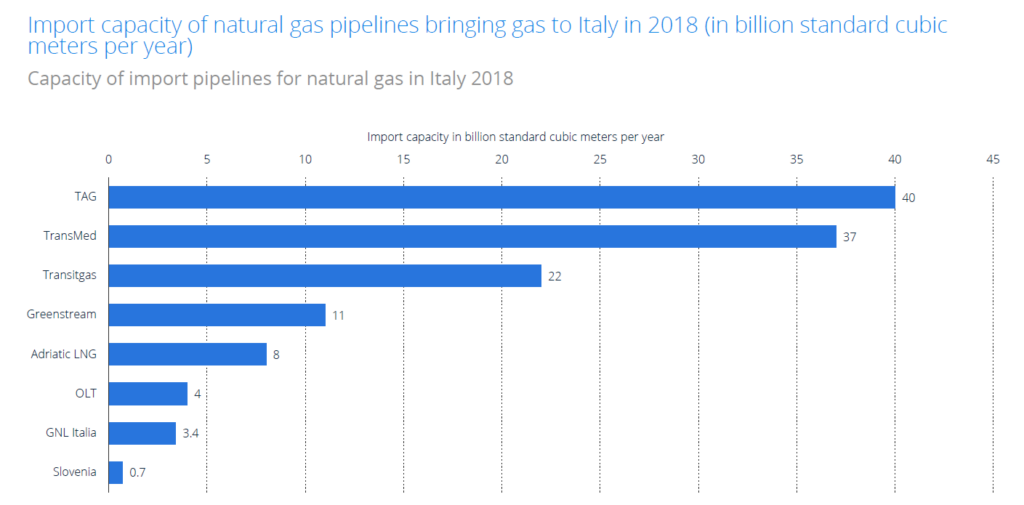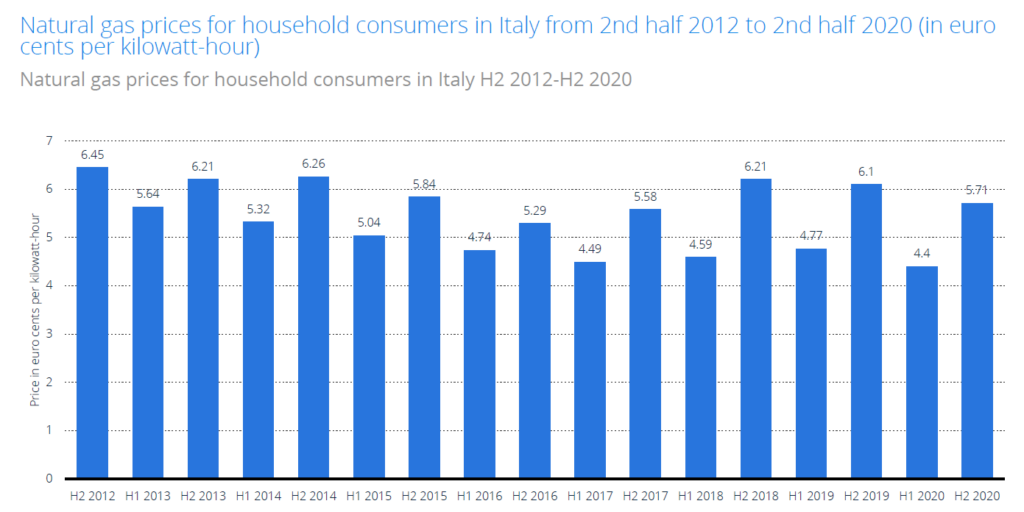After several months of research, we are happy to announce our first report about LNG & Natural Gas energy in Italy. This report is the result of thorough research, data analysis, and consultations with experts in the energy sector. With over 60 pages filled with graphs, tables, and useful information, this report serves as a valuable tool for journalists, data-driven companies, and market insiders.
Natural gas is a significant source of energy in Italy, accounting for over 30% of the country’s total energy consumption. Italy is the third-largest natural gas consumer in Europe, after Germany and the United Kingdom. The country’s high dependence on natural gas has been driven by a combination of factors, including its role as a transitional fuel towards decarbonization, its flexibility in balancing intermittent renewable energy sources, and its relatively low carbon intensity compared to other fossil fuels.
The Italian natural gas market is characterized by a high level of integration with the European market, with cross-border pipelines connecting Italy to several neighboring countries, including France, Switzerland, and Austria. The country also has access to liquefied natural gas (LNG) through several import terminals located along the coast. These terminals receive LNG shipments from countries such as Qatar, Algeria, and Nigeria.
One of the key drivers of the Italian natural gas market is the power sector, which accounts for over 40% of the country’s total gas consumption. Natural gas is widely used for electricity generation, both in combined cycle gas turbines (CCGTs) and open cycle gas turbines (OCGTs). The use of natural gas in power generation is driven by its flexibility, low emissions, and relatively low cost compared to other fossil fuels.
Another important sector for natural gas in Italy is the residential and commercial sector, which accounts for around 30% of the country’s total gas consumption. Natural gas is widely used for space heating, hot water production, and cooking in households and commercial buildings. The use of natural gas in the residential and commercial sector is driven by its convenience, low emissions, and relatively low cost compared to other fuels such as oil and propane.
The industrial sector is another important consumer of natural gas in Italy, accounting for around 25% of the country’s total gas consumption. Natural gas is widely used in the industrial sector for process heat, steam production, and as a feedstock for the production of chemicals and fertilizers. The use of natural gas in the industrial sector is driven by its reliability, flexibility, and relatively low cost compared to other fuels such as coal and oil.
The Italian natural gas market is highly competitive, with several players operating in different segments of the value chain. The upstream segment is dominated by ENI, the country’s largest integrated energy company, which has a significant presence in the exploration and production of natural gas both in Italy and abroad. Other important players in the upstream segment include Edison, TotalEnergies, and Shell.
The midstream segment of the natural gas value chain in Italy is characterized by a high degree of infrastructure development, including pipelines, storage facilities, and LNG terminals. The infrastructure is operated by several players, including Snam, the country’s largest natural gas infrastructure company, and international players such as Fluxys, GRTgaz, and Trans Austria Gasleitung.
The downstream segment of the natural gas value chain in Italy is characterized by a high level of competition among gas distributors and retailers. The gas distribution network in Italy is owned and operated by several companies, including Snam, Italgas, and Hera. Retailers compete with each other to offer natural gas to residential and commercial customers, with players such as Enel Energia, Eni Gas e Luce, and Edison Energia.
Despite the significant role of natural gas in Italy’s energy mix, the country faces several challenges related to its energy transition. The transition towards a more sustainable and low-carbon energy system is a priority for Italy, which aims to achieve carbon neutrality by 2050. To achieve this goal, the country needs to reduce its dependence on fossil fuels, including natural gas, and increase the use of renewable energy sources such as solar, wind, and hydropower.
One of the main challenges for Italy’s energy transition is the need to ensure energy security and affordability while reducing greenhouse gas emissions. The country’s reliance on natural gas as a transitional fuel presents a trade-off between reducing emissions in the short term and achieving long-term decarbonization goals. To address this challenge, Italy needs to accelerate the deployment of renewable energy sources, improve energy efficiency, and develop new technologies to enable the decarbonization of the natural gas sector, such as carbon capture and storage (CCS) and hydrogen production.
Another challenge for Italy’s energy transition is the need to address the social and economic impacts of the transition, particularly in regions that are heavily dependent on fossil fuels. The closure of coal-fired power plants and the shift towards renewable energy sources and natural gas may have significant implications for local communities and workers. To address these impacts, Italy needs to develop a comprehensive strategy for a just transition that includes measures to support affected communities, provide retraining opportunities for workers, and ensure a fair and equitable distribution of the benefits of the transition.
In conclusion, natural gas is a significant source of energy in Italy, with a wide range of applications in the power, residential and commercial, and industrial sectors. The country’s high dependence on natural gas presents both opportunities and challenges for its energy transition towards a more sustainable and low-carbon energy system. Our report provides valuable insights into the Italian natural gas market, its key players, and its role in the country’s energy mix. We hope that this report will serve as a useful tool for journalists, data-driven companies, and market insiders and contribute to the ongoing discussions about Italy’s energy transition.
With more than 60 pages full of graphs and useful information, our report is a tool for journalists, data-driven companies and marked insider.
Below you can find some excerpts of the content of the book.


If you are interesed in a copy of this selected report, write to us info@htc-sagl.ch